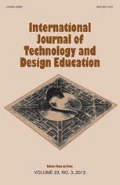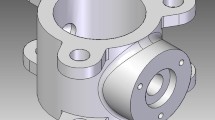Abstract
The ease with which 3D CAD models may be modified and reused are two key aspects that improve the design-intent variable and that can significantly shorten the development timelines of a product. A set of rules are gathered from various authors that take different 3D modelling strategies into account. These rules are then applied to CAD strategic-knowledge learning methodology and included in 3D CAD modelling exercises for students following the degree in mechanical engineering at the University of Burgos (Spain). The experiment was conducted in two groups with a total of 75 students. The design-intent rules were introduced in the different exercises that the teacher explained in both the theoretical and the practical classes. In addition, a summary of the different design rules in each of the practical exercises was explained in the practical classes in only one of the groups. The experimental results, reported in this paper, tested the influence of these summaries on overall improvements in 3D modelling and on the design-intent variable, which is subdivided into four sections: skeleton, structures, alterations and constraints. The use of the summaries of the design intent rules led to statistically significant improvements in 3D modelling in the experimental group, in comparison with the group of students to whom those summaries were not explained.




Similar content being viewed by others
References
Alducin-Quintero, G., Rojo, A., Plata, F., Hernández, A., & Contero, M. (2012). 3D model annotation as a tool for improving design intent communication: A case study on its impact in the engineering change process. In Proceedings of the ASME design engineering technical conference, 2012 (parts A and B, vol. 2, pp. 349–356). doi:10.1115/DETC2012-70872.
Ault, H. K. (1999). Using geometric constraints to capture design intent. Journal for Geometry and Graphics, 3(1), 39–45.
Barbero, B. R., & García, R. G. (2011). Strategic learning of simulation and functional analysis in the design and assembly of mechanisms with CAD on a professional master’s degree course. Computer Applications in Engineering Education, 19, 146–160. doi:10.1002/cae.20300.
Bi, Z. (2013). Teaching of parametric modeling methodologies for undergraduate engineering students. WSEAS Transaction on Advances in Engineering Education, 10(1), 1–13.
Bodein, Y., Rose, B., & Caillaud, E. (2013). A roadmap for parametric CAD efficiency in the automotive industry. Computer-Aided Design, 45(10), 1198–1214. doi:10.1016/j.cad.2013.05.006.
Bodein, Y., Rose, B., & Caillaud, E. (2014). Explicit reference modeling methodology in parametric CAD system. Computers in Industry, 65(1), 136–147. doi:10.1016/j.compind.2013.08.004.
Burón Orjas, J. (1993). Ensenar a aprender: Introducción a la metacognición [Teaching to learn: Introduction to metacognition]. España: Bilbao.
Camba, J., Contero, M., Michael, J., & Company, P. (2014a). Extended 3D annotations as a new mechanism to explicitly communicate geometric design intent and increase CAD model reusability. Computer-Aided Design, 57, 61–73. doi:10.1016/j.cad.2014.07.001.
Camba, J., Cosin, A., & Contero, M. (2014b). An evaluation of formal strategies to create stable and reusable parametric feature-based 3D models. In ASME 2014 international mechanical engineering congress and exposition; systems, design, and complexity, Montreal, Quebec, Canada, November 14–20 (vol. 11, pp. 1–7). doi:10.1115/IMECE2014-37859.
CEEB. (1939). Special aptitude test in spatial relations. USA: Developed by the College Entrance Examination Board.
Chester, I. (2007). Teaching for CAD expertise. International Journal of Technology and Design Education, 17, 23–35. doi:10.1007/s10798-006-9015-z.
Contero, M. (2015). Gestión de anotaciones 3D sobre modelos CAD para mejorar el proceso de diseño en ambientes industriales y arquitectónicos. http://www.labhuman.com/es/node/800. Accessed 15 Jan 2015.
Córdova, F. (2009). Aprendizaje estratégico y metacognitivo. Un enfoque Cognitivo y constructivista [Strategic and metacognitive learning. A Cognitive and constructivist approach]. http://es.slideshare.net/alethias48/aprendizaje-estrategico-y-metacognitivo. Accessed 12 July 2014.
Drury, J. L., Pfaff, M. S., Klein, G. L., & Liu, Y. (2013). Decision space visualization: lessons learned and design principles. Paper presented at the Proceedings of the 15th international conference on human–computer interaction: Interaction modalities and techniques—volume part IV, Las Vegas, NV.
Gebhard, R. (2013). A resilient modeling strategy. Paper presented at the Solid Edge University 2013, Cincinnati, OH, June 24–27.
Hartman, N. W. (2004). The development of expertise in the use of constraint-based CAD tools: Examining practicing professionals. Engineering Design Graphics Journal, 68(2), 14–26.
Hartman, N. W. (2005). Defining expertise in the use of constraint-based CAD tools by examining practicing professionals. Engineering Design Graphics Journal, 69(1), 6–15.
Herrera, A., & Marcelo, N. (2006). La Metacognición en la educación [Metacognition in education]. http://www.monografias.com/trabajos34/metacognicion-escuela/metacognicion-escuela.shtml. Accessed 5 July 2014.
Iyer, G. R., & Mills, J. J. (2006). Design Intent in 2D CAD: Definition and survey. Computer-Aided Design and Applications, 3(1–4), 259–267. doi:10.1080/16864360.2006.10738463.
Jackson, C., & Buxton, M. (2007). The design reuse benchmark report. Seizing the opportunity to shorten product development. Boston: Aberdeen Group.
Kimura, F., & Suzuki, H. (1989). A CAD system for efficient product design based on design intent. CIRP Annals - Manufacturing Technology, 38(1), 149–152. doi:10.1016/S0007-8506(07)62672-9.
Mandorli, F., & Otto, H. E. (2013). Negative knowledge and a novel approach to support MCAD education. Computer-Aided Design and Applications, 10(6), 1007–1020. doi:10.3722/cadaps.2013.1007-1020.
Otey, J., Company, P., Contero, M., & Camba, J. (2014). A review of the design intent concept in the context of CAD model quality metrics. Paper presented at the 121st ASEE Annual Conference & Exposition, Indianapolis, IN, June 15–18.
Rynne, A., & Gaughran, W. (2008). Cognitive modeling strategies for optimum design intent in parametric modelling (PM). Computers in Education Journal, 18(1), 55–68.
Salehi, V., & McMahon, C. (2009a). Action research into the use of parametric associative CAD systems in an industrial context. In M. Norell Bergendahl, L. Leifer, P. Skogstad, & U. Lindemann (Eds.), 17th international conference on engineering design, Palo Alto, CA, USA, 24–27 August (vol. 5, pp. 133–144).
Salehi, V., & McMahon, C. (2009b). Development of a generic integrated approach for parametric associative CAD systems. In M. Norell Bergendahl, L. Leifer, P. Skogstad, & U. Lindemann (Eds.), ICED 09, the 17th international conference on engineering design, design methods and tools (pt. 1), Palo Alto, CA, USA, August 24–27 (vol. 5, pp. 145–156).
Salehi, V., & McMahon, C. (2011). Development and application of an integrated approach for parametric associative CAD design in an industrial context. Computer-Aided Design and Applications, 8(2), 225–236. doi:10.3722/cadaps.2011.225-236.
Ugartetxea, J. (2001). Motivación y Metacognición, más que una realción [Motivation and Metacognition, more than a relationship]. Revista ELectrónica de Investigación y EValuación Educativa (RELIEVE), 7(2-1). http://www.uv.es/RELIEVE/v7n2/RELIEVEv7n2_1.htm. Accessed 5 July 2014.
Yang, J., & Han, S. (2006). Repairing CAD model errors based on the design history. Computer-Aided Design, 38(6), 627–640. doi:10.1016/j.cad.2006.02.007.
Ye, X., Peng, W., Chen, Z., & Cai, Y.-Y. (2004). Today’s students, tomorrow’s engineers: an industrial perspective on CAD education. Computer-Aided Design, 36(14), 1451–1460. doi:10.1016/j.cad.2003.11.006.
Zhang, Y., & Luo, X. (2009). Design Intent information exchange of feature-based CAD models. In World congress on computer science and information engineering, Los Angeles, CA, March 31–April 2, 2009 (vol. 3, pp. 11–15). IEEE. doi:10.1109/CSIE.2009.536.
Author information
Authors and Affiliations
Corresponding author
Rights and permissions
About this article
Cite this article
Barbero, B.R., Pedrosa, C.M. & Samperio, R.Z. Learning CAD at university through summaries of the rules of design intent. Int J Technol Des Educ 27, 481–498 (2017). https://doi.org/10.1007/s10798-016-9358-z
Accepted:
Published:
Issue Date:
DOI: https://doi.org/10.1007/s10798-016-9358-z




